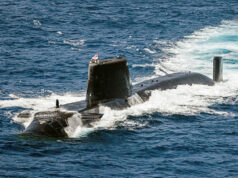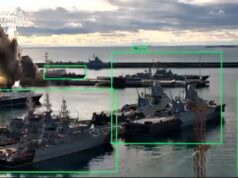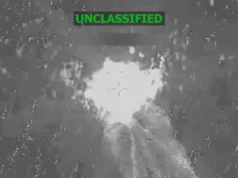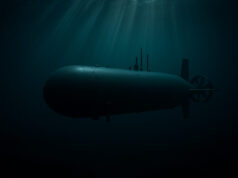The following comes from a formal meeting of the Defence Select Committee, an oral evidence session specifically, discussing the recent defence review whitepaper ‘Defending Global Britain in a Competitive Age’.
Just so you know who’s who, Dr Sidharth Kaushal is a research Fellow at the Royal United Services Institute and Rear Admiral Alex Burton is the former Commander UK Maritime Forces. Stuart Anderson and Mark Francois are both Conservative MP’s.
Fore more on the paper being discussed, feel free to browse the summary linked to below.
Stuart Anderson asked, referring to the Integrated Review’s ‘Defence Command Paper’:
“Do you see any particular areas of concern with what has been set out, doctor?”
Dr Kaushal responded:
“I would not necessarily state that the force structure laid out produced any particular areas of concern for me. The temporary trough in capability that the Navy will endure when the two Type-23s are retired will probably generate certain force generation issues, although in all likelihood not insurmountable ones. The Navy, however, will need to look at two key questions: first, the absence of a capability to counter anti-ship ballistic missiles on the Type-45 destroyer. That was discussed in the 2015 strategic defence and security review, as part of a wider ballistic missile defence capability for the vessel, but it was absent in this review, which I thought was noteworthy.”
Rear Admiral Burton also responded by saying “I would just reinforce Dr Sidharth’s view on the anti-ballistic missile defence, which I think was a wrong absence within the review”, he added later “one of the gaping holes within the defence review is an anti-ballistic missile defence mechanism, both at sea and ashore.”
Mr Francois pressed the point, asking “To be clear, a gaping hole, in your words?”
Rear Admiral Burton responded:
“There is a gaping hole in our ability to defend a carrier against a ballistic missile without the support of our allies, so there is mitigation there, but it is mitigation that is reliant on our allies.”
Burton later added:
“The Navy has been clear that there has been a national capability gap, for the last 10 years, at least, in an anti-ballistic missile defence capability. That can be mitigated by working alongside our allies, just like the Americans use our capabilities to mitigate their capability gaps. Firstly, this is known, and, secondly, it can be mitigated.”
It should be
You can read the full transcript here.
With regards to Type 45 and the idea of arming them against ballistic missiles, this was last talked about officially back in 2019.
UK still ‘investigating potential’ of Destroyers in ballistic defence role














I read that last month Dauntless’ completed an overhaul of its SM1850 radar, which would have been compatible with the same ABM modifications as have been provided to the HNLMS De Zeven Provinciën Frigate. But those modifications weren’t made.
As Dauntless was the first of the Type 45s to get the radar overhaul, does anyone know if any of the Type 45s are scheduled to trial the Smart MM style modifications, allowing ballistic missile tracking?
https://www.navalnews.com/naval-news/2021/03/thales-completes-hms-dauntless-s1850m-long-range-radar-overhaul/
https://ukdefencejournal.org.uk/ballistic-missile-defence-and-the-type-45-destroyer/
The T45s already demonstrated the ability to track ballistic missiles, but unless an actual anti-ballistic missile weapon is selected for procurement, there’s little purpose in paying for extra radar upgrades.
According to Defence Under-Secretary Stuart Andrew in a written parliamentary answer, “the United Kingdom is considering the Aster Block 1NT for equipping its T45 Destroyers.“
Knowing Britain that will be too expensive so they will strap a few GPMG’s on the rails.
Like it 💰
Yes but they will be anti ballistic missile GPMGs.
You know? No such thing as a state secret any more.
Yes they have managed to create a three stage orbital booster and exo atmospheric kill vehicle that can be fired out of a GPMG. It’s seems the they tea-leafed the idea from Russia state media after it showed plans for the development of a man portable ICBM.
There is a massive capability differences between the S1850M and the SMART-L MM radars. The S1850M is PESA for starters whilst the MM is AESA. Furthermore, S1850M can really only track objects in very low earth orbit, whilst the MM can track those in a medium orbit. Therefore, the MM can track ICBMs whereas the S1850M will only track them in the terminal phase.
As an example the SMART-L MM radar when being tested in Holland tracked the test ballistic missile used for Formidable Shield Exercise, i.e a distance over nearly 1000nm, the S1850M can’t do that.
Oops forgot to say the a Dutch Navy frigate equipped with a SMART-L radar was used to track the missile and feed the info to an Arleigh Burke, that then fired a SM3 to shoot it down. There have been subsequent exercises where the Dutch had a frigate with the newer MM radar was used to help track a ballistic missile. The Dutch are now looking at buying SM3 for their ships.
The Dutch certainly have an admirable aspiration to develop ship-borne BMD, particularly in the radar sector.
HMS Daring is next for it’s PIP Upgrade so logically it would have gone through the same process ( at a guess ) as Dauntless – id doubt if there is sufficient Funding for the Modifications to the Radar at this time.
The PIP upgrade is a separate contract, done at Camell Laird.
Refits for T45s are done in Portsmouth.
Correct , the Refit was carried out in Portsmouth before the Ship sailed to Camell Laird’s for the Engine work,i didn’t suggest they were carried out at the same time and place.
The way that the MoD have released this info, suggests the radar upgrade has been done after Dauntless return to Portsmouth.
Ho well, very confusing!
Ships don’t stay on one spot with a target anchored to the sea bed.
How accurately does a ballistic missile have to be? By ballistic it must have taken off and at high speed up into the stratosphere or where ever … on a ballistic trajectory … a trajectory that has been one presumes computed before its taken off … on a long distance flight.
What explosive weight is intended for these putative ballistic missiles? Nuclear?
Ive always asked myself this same question Trevor. How do you guide a ballistic missile doing Mach 10 to hit a manoeuvring target? Nothing on the nose of the missile is going to work I wouldn’t have thought. Only thing I can think of is a low orbit satellite (or a HALE UAV) updating GPS coordinates in real time down the missile’s chuff. Also something doing Mach 10 must find it difficult to do much course correction. As you say, what size warhead will you need? Nuclear? Unless, of course, on re-entry the missile is slowed down significantly. But then it kind of defeats the object?
Some anti-ship BMs will perform manoeuvres to ‘avoid interception’, though in reality this is to bleed enough speed to the point where the plasma that forms on the leading edge of the warhead disperses and the missile’s seeker will be able to operate.
Otherwise, communication links can sometimes be established with external guidance, though this does necessitate other assets to be close enough to get a track on the target, somewhat negating the BM’s range advantage.
Third party targeting and slowing the missile down both negate the advantages of a BM, i would have thought. At what point does a slowed down BM become just another high diving anti ship missile?
Even when slowed down due to the interaction with the atmosphere these things are still comfortably in the hypersonic range.
Do these anti ship BM’s have MIRV’s like nuclear ones?
If so they could cover a wider area around a moving target?
They are Wire Guided by the bloke with the strongest shoulders and best long distance eyesight. Pretty sure I’m right.
Haha! Good one Captain P
So wrong, they have a little mouse in MIRV, it’s been trained to associate aircraft carriers with cheese and to control the direction of the MIRV with little mouse sized buttons.
squeeeeaaaaaaakkkkkkkaaaaaabbbbbooommm
On the Tube there is a channel called Covert Cabal, recently he did a good video on Chinese ASM’s ( the ballistic kind ) Conclusions were that a ship moves, the speed is so fast on the missile course corrections are almost impossible. So basically he said they being ballistic, they are not so accurate to use against a ship.
I suppose it is what kind of ballistic missile, and where and how it is being used that’s the question.
Israel’s Iron Dome has failed to intercept some fairly basic incoming Hamas rounds. Also in Syria, S300 and S400 have failed to intercept at times, the Russian Pantsir is much-vaunted, but I read the radar lets it down badly.
There was a British boast a few years ago that one Type 45 anchored in the Thames estuary could protect most of south-east England from incoming ballistic missiles.
I tend to err on caution when claims are made without evidence. Tests are always made in none war situations.
Thanks Jan. interesting to read this. I remain highly sceptical regarding the capability of a ballistic missile hitting a moving target
Depends on how many missiles the enemy is willing to throw at our ships. A similar subject would be US covert aircraft. U2 & F-117 were usually safe if only one missile was fired at them, but if multiple missiles were fired, they sometimes were hit by one while avoiding another. Going from memory, one U2 was shot down because the Russians fired 11 missile at it. WW2 torpedoes were the same. You fired a spread, in the hope one would hit.
I am sceptical of all industry claims tbh. Before the UK I experienced kit being made to meet a particular national need ( Armscor ) It may not have won prizes for appearance but a lot of lives were saved because it was designed using the input at all levels from those going to use it.
The Gan proved also that UOR kit like Husky and other vehicles can be great assets if “boots” are listened to.
I know a Tar who worked on Seawolf, industry claimed it could track and shoot down a tennis ball-sized target. Said Tar repudiated that in a language I do not understand.
I think that ABM defence for the RN and the wider UK is a big gap, especially given the increasingly effective missiles being developed by China and Russia. I would also point out the North Korea allegedly has missiles capable of striking the US so how long before they can target Europe or indeed sell these weapons or the technology to Iran which already has the ability to threaten Eastern Europe?
However, I also think that whilst there does not appear to be a specific project to equip the T45’s as yet, there is enabling work going on. Trials were undertaken to prove that the T45’s radar can track BM’s, BAE Sytems have proposed upgrades to the SAMPSON radar with ABM capability a core element of the proposals and the S1850 radar has already been updated to AESA which I believe improves its’ ability to track BM’s. I would suggest that all of this work would contribute to reducing the risks associated with fitting the T45’s with an effective ABM capability.
It seems to me that we need a decision at high level to make this happen. I would also hope that the opportunity is taken to enhance and upgrade the basic AD capabilities to keep the SAMPSON radar of Sea Viper current into the next decade. Hopefully the activity above is suggestive of active consideration of a project…
Cheers CR
S1850M has not received the SMART-L-MM AESA upgrade.
Just to be clear …the SMART-L MM (previously known as ELR/EWC) is NOT an upgrade of the earlier SMART-L/ S1850M, but a completely new radar that doesnt have any parts commonality with the older PESA radars.
Perhaps it does not need the update with SAMPSON. I understand that it can track such targets. There is talk of a SAMPSON update that may add extra capability for ABM work. I suspect this will form the basis for T45 ABM capability with ASTER 30 1NT.
There is a very big difference between ballistic missile defence for an RN task force and Ballistic missile defence for the U.K as a whole and they need to be clearly separated in conversations.
if you are looking at a defence of the all home soil against all Types of BM threat then you need to defend against IRBMs and ICBMs( there is no nation in range that would conceivably us SRBMs against the U.K It would always be IRBMs or ICBMs, So you would need:
• A command-and-control and communications system that integrates all the sub-systems of the BMD architecture to allow near-time situational awareness and sensor-to-shooter times, enabling interceptors to target missiles throughout their flight
• At least one ground-based interceptor in the UK capable of intercepting and destroying IRBMs/iCBMS during the midcourse phase of flight using kinetic hit-to-kill technology
• Space-, air-, ground- and sea-based sensors, with ground- and sea- based interceptors capable of intercepting all ballistic-missile types
• Land- or sea-based interceptors permanently based in the Falklands, Cyprus and Gibraltar
• Deployable BMD capabilities with the ability to provide requisite levels of force protection to deployed UK forces. Ideally, such a system would not lead to additional stress for the logistics tail of the deployed force, nor require third-party approval to engage targets (when a British system has to be based in another state
As we don’t have a space a fully fledged space sector ( in this case we are talking about the ability to build and launch three stage orbital launch vehicles). To get a worthwhile BMD system for the U.K. would have a capital cost somewhere north of £60 billion with a further Annual costs of 5-6 Billion every year. As an example it’s estimated for the US system ( which itself is only designed to protect against handfuls of ICBMs at most) its taxpayers have forked out between 150-200 billion dollars.
When it comes to the threat of weapons of mass destruction being used against the U.K. it’s just more cost effective to make sure you can prevent attack by being clear you are ready and able to end the offending body politic ( simple physics dictates is easier to lob lots of MIRVs at a nation compared to Intercepting MIRVs with exo-atmospheric kill vehicles).
The debate for the U.K is all about Protecting U.K. forces from short range/medium range ballistic missiles and maybe a very limited (rogue North African state somehow getting a IRBM capability) U.K. defence. Looking at SM3 you can get a working limited IRBM defence for around 2 billion pounds, but that would be limited and effectively remove a third of the type 45 force for U.K. deployable assets as they would be needed in home waters, so you would then need 2 new air defence destroyers, which stacks up the billions.
It’s all money money money at a time the magic money trees infected with a pandemic and is withering away in lockdown.
There are some really good papers on BM defence as it’s a well published area. Really worth a read as it shows just how much effort the US has taken to get where it is, the development of the GBI is really worth a read.
On that front, as reported in Janes: “Israel have just reported that Iran’s Zoljanah two-stage satellite launch vehicle would be able to carry a 1 ton warhead 5000km. The 5000km range, would enable Iran to target every European country, including Iceland.”
So it seems Iran is constantly evolving its “satellite” launch technology, which can be repurposed for military use. Iran, aren’t stupid enough to fire a missile from their own territory at a European country, as they will get an overwhelming response, especially from NATO. The issue is Iran has shown that it will give its latest technology to close affiliates, like in Yemen. Who then use and overtly test then clearly give feedback on how well it performed, where Iran then evolve it to the next iteration.
This is the main threat that a UK based ballistic missile defence system should be put in place for. With the number of ICBMs that Russia, has along with the number of MIRVs each hold. I don’t believe a ABM system is available that could stop them all, which is where MAD helps as the insurance policy.
Just read the full Defence Select Committee transcript
So to spell a few things out…
a) We need a better budget because >
b) Our ships need an Anti ship\Land strike missile fitted
c) We need a counter-ASBM capability,
d) the Navy like having OPVs and want to see them improved, modular and better armed. Can use them to experiment with modular weaponry etc
e) With regard to the MCM, Government and Department not being pacey and innovative enough
f) Pace of funding of FCF not fast enough
And more 😉
Ha ha, sounds like a typical thread on here !
They forgot the helicopter carrier for the Royal Marines!
HMM, I think these guys may be spinning this a bit.
I don’t doubt that anti-ship ballistic missiles pose a threat to the CSG, but let’s remember that most of the people who would actually shoot at us don’t have them (Iranian proxy forces in the middle east being the only people recently to have launched ASMs at a NATO warship recently). China has them, but has never proven their targetting capabilities, and I’m not sure whether Russia has them or not. So I’d hardly consider them to be a widely proliferated threat to our fleet.
Also, for R.Adm. Burton to try and reinforce the threat by talking about threat to shore as well as at sea I though was a it disingenuous. As far as I’m aware, the only ship-based ABM system that can do anything other than terminal phase shoot down is the US SM missile based system. We’re not, at this point talking about shooting down ballistic missiles on their way to the UK, not least because we don’t have a picket of T45s in the GIUK gap. A solution for the T45s would only be a solution for the land in the same way AEGIS ashore is, upgrading the T45’s radars isn’t going to fix it- building new radar systems ashore will.
I’ve got nothing against an ABM capability, but I’m fine with just jumping on Aster 30 Block1NT at this point. Save the cash for the T83, when anti ship ballistic missiles may have matured enough to be an actual threat.
A warhead in terminal phase has Not been shot down yet. A ‘warhead vehicle’ has been shot down in mid course phase by a sm-3. A T45 picket would need to be positioned in the Baltic.
Thanks, I wasn’t aware that none had been shot down in terminal phase yet! All I meant was that the Aster ABM solution is for terminal phase kill, I think? I may be wrong though. Yes, the SM series missiles are the kings of the game at the moment, even if just because they’re about the only option until the block 1NT comes in.
Sorry, I really didn’t know where they’d have to be in order to swat down incoming missiles, I just knew that we wouldn’t be able to permanently station a bunch of T45s out there! Either way, not a realistic proposition.
Not sure where that info has come from, SAMPT alone has successfully intercepted an Israeli Black Arrow SRBM target with an Aster Block 1 missile (only capable of terminal-phase interception) in 2013.
You are correct, Aster block 0, 1 and 1NT are only capable of terminal-phase interception with effectiveness increasing respectively. Aster Block 2 is supposedly a mid-course interceptor, however the state of the program is not known.
Thanks for the correction, wasn’t very aware of SAMPT!
For now, I think Blocck 1NT is sufficient if we’re going to upgrade- it’s not like we’re needing to shoot down ballistic missiles very often at present or the near future. Save investment for the future ships, the T45s should be able to handle the airborne threats they’re likely to face just fine for now.
Actually shooting down a warhead in the terminal phase has been demonstrated on numerous occasions by the SM-3 and the THAAD system.
So if that is the case, why has not a Trident warhead ever been shot down then?
Couple of points here.
The success rate of the SM-3 and the THAAD has improved significantly over the past few years with THAAD proving it can reliably hit these targets. What is most impressive is that they both use a kinetic kill vehicles rather than an explosive warhead. The science and engineering behind this is mind bending when you think about it. Both of these are designed for shorter range missiles by the way although the SM-3 successfully hit an ICBM representative target for the first time last year. The SM-3 has also been proven as an anti satellite weapon as well.
Trident and other mirv capable ICBMs are a different level completely. These reenter the atmosphere at speeds approaching Mach 25 and employ decoys and other penetration aids. The do slow down rapidly after hitting the atmosphere but perform violent maneuvers to defeat abm systems. Nobody is stopping a full on icbm attack from a country like the US, Russia, China, UK, France. Not in our lifetime in my opinion.
Yes I agree, it is impossible to shoot down a mirv at Mach 25
Just to be clear here, the THAAD, SM3 and SM6 have all demonstrated the ability to destroy ballistic missiles in their terminal phase. It’s very unlikely any of these targets were moving at the speeds discussed but still a very impressive capability.
I do remember it being in the papers nearly a decade ago about using T45s as an anti Ballistic missile defence potentially for the whole country. Unrealistic I know but just thought I would mention it, it was about discussions going on so probably involved what upgrades would be needed to create a credible defence. Though numbers alone would pretty much preclude that I suspect particularly if they were to do their normal duties.
You would need all six T45s constantly on station around the UK to provide ABM cover. Even then they would be able to provide 100% cover.
The SM3 can shoot down MIRVs in both the terminal and cruise phases, so can THAAD, but it hasn’t been as successful as SM3. The USN are also looking at SM6s to see if they can be used to engage MIRVs in the terminal phase.
The DF21D has been used in exercises and shown it has a good hit probability. The issue being all the targets have been anchored barges and not moving targets! For a “standard” nuclear” armed MIRV hitting or slightly missing a target is not a problem, as they as a rule target high value strategic fixed targets, such as missile silos etc. They only have a combined inertia navigation-GPS unit, possibly with a star map sensor. They don’t have a primary radar or an optical sensor. However, it has been reported that the DF21D may have both. If this is the case, they will have to slow down the MIRV to below Mach 7, preferably Mach 5 to dissipate the plasma sheath. Which would otherwise inhibit both the radar and optical sensors. At these much lower speeds they won’t be a problem for Sampson to track and for Aster to engage.
But that all still relies on knowing where the target ship is plus a constantly updated heading and speed, to put the missile’s MIRV in the right place. Thus it will become more crucial to identify and kill the targeting chain. Which will boil down to preventing subs and recon aircraft from getting close, taking out or blinding recon satellites. Then preventing the fishing vessel festooned with aerials from following you.
Anti-ship ballistic missiles will be a threat, if they can maintain track on your vessel, otherwise they are a threat that can be easily mitigated with current technology. Though having a Dragonfire type of laser may be useful for blinding or damaging the solar sails of a satellite may be useful.
Are you saying that Trident is already obsolete? It seems like a well known campaign group propaganda, to me?
Nope far from it. A Trident’s MIRV doesn’t need to slow down to find its target. It doesn’t use a radar or optical sensor to search for or lock on to its target. The target is pre-programmed therefore, it flies to a preset fixed location. The MIRV when re-entering the atmosphere will spiral in towards its target to try and throw off any intercepting missiles. It will not do so violently as that would slow it down too much. It will re-enter at speeds greater than Mach 10, and build up a plasma layer that gets thicker the further into the atmosphere it goes. You will be able to track its fall visually. However, once it reaches denser air, it will start to slow down due to atmospheric drag. Depending on the time of flight within the atmosphere, the MIRV may have slowed down to just over Mach 7 as it hits the target or detonates above the target.
Thanks for your always informative responses!
I have read ont he Warzone that this is the key weakness of ballistic missiles and moving targets- how they find them in the first place. I’m glad that what we have is probably about sufficient for handling the current crop of DF21Ds, even assuming that they can be targetted onto moving vessels.
It reinforces my feeling that we can concentrate on other systems now, and save the more advance ABM gear for the T45 successor.
It certainly would be nice if other countries like the Brits, ect could help out the US when it comes to BMD capabilities. As everyone knows it is extremely expensive and having the American taxpayer shoulder the entire cost isn’t fair. Other countries either need to develop their own capabilities or buy the American stuff to help shoulder the load and take pressure off the limited American resources.
I see little merit in putting a couple of ABMs on a couple of Destroyers. They couldn’t possibly get to be in the right place at the right time, let alone actually at sea. I’d much rather our glorious politicians and accountants feel to full effect of the consequences of their stupendous funding decisions for the defence of our nation.
RN not even playing catch up on ABM, as we’ve still to enter the field by developing or buying ABM capability. Not just CSGs need this, but the UK itself. HMG must pull its finger out & deliver the defence needed today.
BMD has long been an aspiration of the Royal Navy, with SAMPSON itself being a development of MESAR2, a radar specifically developed for ballistic missile tracking. 2 major exercises have been conducted where SAMPSON has successfully tracked SRBM targets using an experimental software version, with the latter also retaining the ability to simultaneously look for conventional air targets.
S1850M, being a version of SMART-L, has upgrade paths available to be upgraded to an AESA radar (essentially the same as SMART-L-MM, potentially with British modifications as S1850M is now) along with the use of ballistic missile tracking-specific software.
Aster also has upgrade paths available, of which the UK could piggy-back off of European developments. Aster block 1 and block 1NT are improved versions for terminal-phase interceptions, Block 1 in service and block 1 NT delivered in 2023. Block 2 is the mid-course interceptor but has likely been subsumed into the European TWISTER program, judging on the absence of new information.
A procurement of the latest block of SM3 would be the most effective, giving the Type 45s a defence against (nearly) the entire spectrum of ballistic missiles (bar ICBMs).
There’s also laser weapons but no guarantee as to when they are delivered, nor their capabilities.
The latest defence review had mentioned upgrading current Aster missiles, presumably this is an upgrade to Block 1/Block 1 NT which can be retrofitted to current Block 0 stocks.
Absolutely shit out by repeating the word ‘mitigating’. If he had the courage to not use that word, or the fact we rely on America for a heck of a lot, the right follow on conversations will have been had. Now they won’t.
He spared blushes of the MOD by being a shit house. Typical.
I am still amazed that as a nation we do not have land based SAMs dedicated to home defence. We have Sky Sabre (if it is even operational yet), but this is for force protection or tactical defence. France, Spain, Italy, Germany etc all have national SAM systems, we do not. I think the last system we had was Bloodhound!
We have to get real and plug this capability gap. Russia in particular has both cruise and ballistic missiles that can hit us without us being able to defend against them. This is just negligence…
Negligence that’s the one ,come HMG it’s coffee ☕time again.
We also have intelligence services and diplomatic institutions, NATO ect, the United Nations that tell us that such events are highly unlikely. Short of WW3 starting. Russia isn’t going to start lobbing ballistic missiles at anyone out of the blue. Certainly not the UK mainland. And if I’m not mistaken, they have nothing that could protect them from a Trident D5. I doubt they could shoot down a TLAM. Let’s keep it real. 👍
The problem is, if someone has an off day and decides to launch one. By that stage for us it would be too late!
I thought we should be ready for WW3! Is that not the point of defence and the prime responsibility of government to protect the UK.
It is. But it’s a balance between requirement, money available, and genuine need, and the threats we face. The MOD can’t be a bottomless pit. We are spending 190Bn over the next 10 years on equipment, along with a need to balance the books, set against a big hit to the economy from COVID. We can’t do it all. And the Russians certainly have big problems with defence equipment and funds.
Hmm not so sure, when Japan hit Pearl the US came up with a somewhat suicidal plan to hit mainland Japan. Letting you enemies know you can hit them were it hurts is a military and political strategy, doesn’t have to nuclear. Western nations have lived relatively decadent life styles compare to some nations and have zero appetite for casualties at home. If things turn hot in Ukraine or similar future conflict zone and the UK did get involved, the enemy may gamble that a conventional attack could swing the British public to either exit the campaign or negotiate.
The Doolittle raid was the US reply to Japan. Sadly it was only to make a point and many died.
Arguably when the Heinkel crew accidentally bombed outer London in 1940, Churchill sent Wellingtons to bomb Berlin, Hitler was so outraged he ordered the Blitz in return.
Points made have severe consequences for those most unable to defend themselves.
https://en.wikipedia.org/wiki/A-135_anti-ballistic_missile_system
HMG said in November last year the armed forces to be cut ,but would be given what there need for the future ,just like there did 30yrs ago when the wall came down so let’s start with BMD for Type 45s 🇬🇧
The statement that kept being repeated by the Rear Admiral was a lack of a neural network within the fleet. Even to the extent he would do without additional ships so long as the remaining were not only UK networked but capable of being networked with NATO allies. Going forward either we buy the USN’s CEC or we develop a UK compatible version. Either way, I believe he is spot on that networking should be made a priority.
First time I’ve heard of a serving member of the top table say they’d like more warships though! Also that he wouldn’t class the OPVs as warships.
He gave very little away about the forthcoming T32, even less about the T45’s replacement or capabilities.
The committee quite rightly raised the concern that a lack of a dedicated mine hunter fleet may hurt the UK’s reputation. It remains to be seen if a frigate equipped with deplorable submersible robots can do both the search for and destruction of mines whilst conducting escorting duties etc. On paper it should work, but until we have a reliable and robust system in place, surely the Hunts/Sandowns must remain?
Hope so
I’m sure those robots are deplorable! 🙂
Last I read is that Sandown’s are going sooner over several years with the Hunts around till the end of the decade.
So a gradual change over rather than wholesale cut while their replacements are still planned. A welcome change?
I agree on the escorts myself.
Deplorable – muppet…
Hopefully the Navy will be allowed to gradually draw down the Hunts and Sandowns. It would look pretty bad if the “deplorable” (deployed) robots weren’t as effective, when the mother-ship is working at distance from the mine.
Hi John,
I’m new to comments on this site but have enjoyed reading it for a long time.
I liked your list there and just wish that there was talk from the MoD of putting Camm (48) as well as TLAM (16) and or ASM (8) and torpedos (2×2) onto the Type 45s – they look wonderful and powerful but could be so much more. Maybe even an UAV to complement the helicopter?
Any photo updates on the final armaments being done on QE and POW aircraft carriers?
Cheers
QD
I agree with you about the Type 45 there could be fitted out to do alot more ,HMG have under cut them selfs with these ships for me.
Quick Question, HAVE WE NEEDED IT YET. i would like a hot tub, but a fart in the bath is all i can afford.